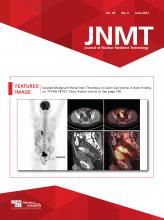Abstract
In the absence of hepatic metastasis in abdominal cancers, an isolated malignant portal vein thrombus is very rare. The presence of a malignant thrombus has clinical significance for determining the stage, treatment, and prognosis. 18F-FDG PET/CECT is a noninvasive modality for discriminating between malignant and benign thrombi. We present a case of primary sigmoid colon carcinoma for which 18F-FDG PET/CT showed, in addition to the 18F-FDG–avid primary lesion, an 18F-FDG–avid filling defect in the portal vein, likely malignant thrombus.
In the absence of hepatic metastasis in abdominal cancers, an isolated malignant portal vein thrombus is very rare. The presence of a malignant thrombus has clinical significance for determining the stage, treatment, and prognosis. 18F-FDG PET/CECT in which the CT portion is performed with contrast enhancement is a noninvasive modality for determining the vessel thrombus/embolus. We present a case of primary sigmoid colon carcinoma for which 18F-FDG PET/CECT showed, in addition to the 18F-FDG–avid primary lesion, an 18F-FDG–avid filling defect in the portal vein, likely malignant thrombus.
CASE REPORT
A 67-y-old man presented with a history of black stools for the last 20 days. He had severe anemia, with a hemoglobin level of 5.0 mg/dL. There was no past history of previous surgery, tuberculosis, hepatitis, or any other chronic illness. On physical examination, there was no specific finding other than severe pallor. On ultrasonography, a long segmental wall thickening was seen in the sigmoid colon and a filling defect in the portal vein. The patient underwent sigmoidoscopy and biopsy of the lesion, histopathologic examination of which revealed moderately differentiated adenocarcinoma.
18F-FDG PET/CECT was performed for staging and to assess the nature of the filling defect in the portal venous system. Fifty minutes after intravenous injection of 370 MBq (10 mCi) of 18F-FDG, PET/CECT was performed on a dedicated hybrid scanner (Discovery STE 16; GE Healthcare). Before the PET/CECT scan, a low-dose scout scan (120 kV, 10 mA) was acquired from the base of the skull to the mid thigh. For the PET/CECT scan, a portal-venous–phase contrast-enhanced CT scan (120 kV, 340 mA) was first obtained from the base of the skull to the mid thigh, 55 s after the beginning of 90 mL of isoosmolar contrast medium had been intravenously injected. After the CECT acquisition, a 3-dimensional PET acquisition was done in the caudocranial direction with an acquisition time of 2 min per bed position.
A maximum-intensity-projection PET image (Fig. 1A) revealed a few hot spots in the paramedian plane of the right upper abdominal region and the pelvic region. Transaxial and sagittal CECT and PET/CECT images of the pelvis (Figs. 1B–1E) revealed 18F-FDG–avid (SUVmax, ∼21.7) long segmental asymmetrical wall thickening in the sigmoid colon.
18F-FDG PET maximum-intensity-projection image (A) reveals few hot spots in paramedian plane of right upper abdominal region and in pelvic region. Transaxial (B and C) and sagittal (D and E) CT images (B and D) and PET/CECT images (C and E) of pelvis reveal 18F-FDG–avid (SUVmax, ∼21.7) long segmental asymmetric wall thickening (arrows) in sigmoid colon, with perilesional stranding and nodularity.
Transaxial (Fig. 2) and sagittal and coronal (Fig. 3) CECT and PET/CECT images of the upper abdomen revealed an 18F-FDG–avid filling defect in the main portal vein (SUVmax, 18.3) and left portal vein (SUVmax, 16.9), suggestive of a malignant thrombus. There was no 18F-FDG–avid lesion in the liver parenchyma.
Transaxial CT images (A and C) and PET/CECT images (B and D) of upper abdomen reveal 18F-FDG–avid filling defect in main portal vein (solid arrows; SUVmax, 18.3) and left portal vein (dashed arrows; SUVmax, 16.9).
Sagittal (A and C) and coronal (B and D) CT images (A and B) and PET/CECT images (C and D) of abdomen reveal 18F-FDG–avid filling defect in main portal vein (solid arrows) and left portal vein (dashed arrows).
After PET/CECT, it was decided to give the patient initial chemotherapy with the capecitabine-plus-oxaliplatin regimen along with oral anticoagulant medication (dabigatran, 150 mg twice daily) rather than surgery. After 3 cycles of chemotherapy, the patient died at his home after a few hours of sudden respiratory distress, possibly from pulmonary thromboembolism (unconfirmed), before a response evaluation could be done.
DISCUSSION
Malignant portal vein tumor thrombosis is a rare entity, seen in approximately only 2%–3% of patients with either primary or secondary malignant liver lesions (1). Possible mechanisms for malignant portal vein tumor thrombosis that have been mentioned in the literature are shunt formation between the hepatic artery and the portal vein and microscopic invasion of the portal vein from an adjacent hepatic lobule (2,3). An isolated malignant portal vein tumor thrombus without liver involvement is very rare, and only a few cases have been reported in the literature (2,3). The possible pathogenesis is a hypercoagulable state induced by the primary malignancy (4). During routine contrast-enhanced CT imaging, venous thrombosis—whether malignant or benign—appears as a low-attenuation area or filling defect in the vein. Therefore, it is difficult to differentiate between tumor thrombosis and blood clot thrombosis on the basis of the CECT data alone (5). 18F-FDG PET/CECT helps distinguish tumor thrombosis from blood clot thrombosis on the basis of the tracer accumulation (6). In the present case, 18F-FDG PET/CECT showed tracer-avid malignancy in the sigmoid colon (primary) and portal vein, with no avid lesions in the liver.
A possible approach to management of such patients is resection of the primary tumor and of the portal venous thrombus followed by chemotherapy along with oral anticoagulants or subcutaneous low-molecular-weight heparin. As per the limited literature available, the prognosis of these patients is poor; our patient died after 3 cycles of chemotherapy, before the disease response could be evaluated (7).
CONCLUSION
The presence of malignant venous thrombi is a poor prognostic factor in malignancies. 18F-FDG PET/CECT is a reliable, noninvasive modality to detect a malignant venous thrombus.
DISCLOSURE
No potential conflict of interest relevant to this article was reported.
Footnotes
Published online Nov. 20, 2020.
- Received for publication June 11, 2020.
- Accepted for publication October 19, 2020.










